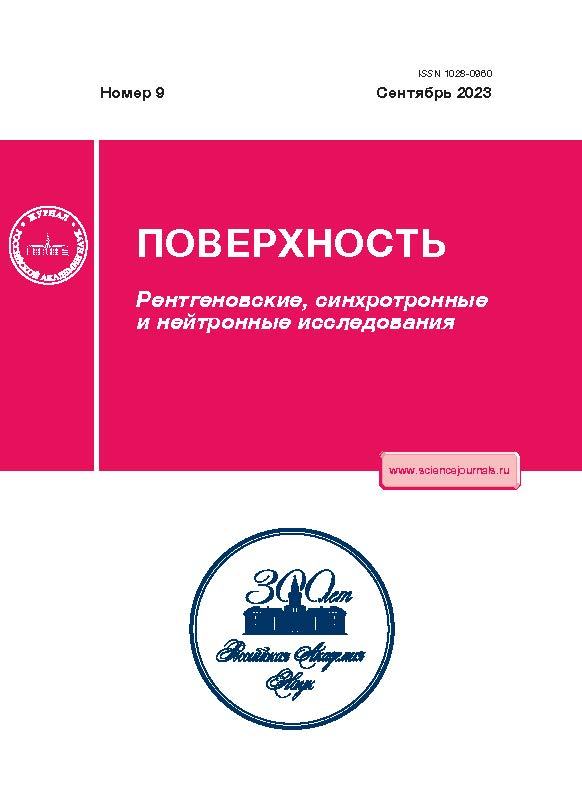Investigation of the Biodistribution of Gd0.5La0.5F3:Eu Nanoparticles in the Internal Tissues of Laboratory Mice Using X-Ray Computed Tomography and X-Ray Fluorescence Analysis
- Autores: Polozhentsev O.E.1, Khodakova D.V.2, Goncharova A.S.2, Pankin I.A.1, Soldatov A.V.1
-
Afiliações:
- The Smart Materials Research Institute, Southern Federal University
- National Medical Research Centre for Oncology of the Ministry of Health of Russia
- Edição: Nº 9 (2023)
- Páginas: 3-10
- Seção: Articles
- URL: https://kld-journal.fedlab.ru/1028-0960/article/view/664499
- DOI: https://doi.org/10.31857/S1028096023090091
- EDN: https://elibrary.ru/ZEUKEE
- ID: 664499
Citar
Texto integral
Resumo
The biodistribution of Gd0.5La0.5F3:Eu(15%) X-ray phosphor nanoparticles in the body and tissues of internal organs of balb/c laboratory mice was studied. Gd0.5La0.5F3:Eu(15%) nanoparticles were obtained by the hydrothermal synthesis at 250°C for 24 h. Using X-ray powder diffraction, transmission electron microscopy, and dynamic light scattering, it was shown that a hexagonal phase was formed in the resulting sample, and the average size of nanoparticles varied in the range 30–40 nm. In vivo experiments have shown that intravenous administration of an aqueous solution of nanoparticles accumulates the sample mainly in the liver and spleen, with the maximum concentration being reached during the first day. According to the results of post-mortem analysis of tissues by micro-CT, it was shown that these nanoparticles formed conglomerates, their distribution over the volume of the organ was homogeneous. X-ray fluorescent analysis of liver and spleen tissue fragments allowed for elemental analysis and mapping. Distribution maps of heavy elements in the composition of nanoparticles (Gd, La, Eu) were similar to Fe distribution maps, which indicated the uniform distribution of Gd0.5La0.5F3:Eu(15%) nanoparticles in the pulp of the internal tissues of the liver and spleen.
Sobre autores
O. Polozhentsev
The Smart Materials Research Institute, Southern Federal University
Autor responsável pela correspondência
Email: oepolozhentsev@sfedu.ru
Russia, 344090, Rostov-on-Don
D. Khodakova
National Medical Research Centre for Oncology of the Ministry of Health of Russia
Email: oepolozhentsev@sfedu.ru
Russia, 344037, Rostov-on-Don
A. Goncharova
National Medical Research Centre for Oncology of the Ministry of Health of Russia
Email: oepolozhentsev@sfedu.ru
Russia, 344037, Rostov-on-Don
I. Pankin
The Smart Materials Research Institute, Southern Federal University
Email: oepolozhentsev@sfedu.ru
Russia, 344090, Rostov-on-Don
A. Soldatov
The Smart Materials Research Institute, Southern Federal University
Email: oepolozhentsev@sfedu.ru
Russia, 344090, Rostov-on-Don
Bibliografia
- Kandasamy G., Maity D. // Mater. Sci. Eng. C. 2021. V. 127. P. 112199. https://doi.org/10.1016/j.msec.2021.112199
- Chen W., Zhang J. // J. Nanosci. Nanotechnol. 2006. V. 6. P. 1159. https://doi.org/10.1166/jnn.2006.327
- Ren X.-D., Hao X.-Y., Li H.-C., Ke M.-R., Zheng B.-Y., Huang J.-D. // Drug Discov. Today. 2018. V. 23. P. 1791. https://doi.org/10.1016/j.drudis.2018.05.029
- Fan W., Tang W., Lau J., Shen Z., Xie J., Shi J., Chen X. // Adv. Mater. 2019. V. 31. P. 1806381. https://doi.org/10.1002/adma.201806381
- Shapoval O., Kaman O., Hromádková J., Vavřík D., Jirák D., Machová D., Parnica J., Horak D. // ChemPlusChem. 2019. V. 84. Iss. 8. P. 1135. https://doi.org/10.1002/cplu.201900352
- Grzyb T., Runowski M., Lis S. // J. Lumin. 2014. V. 154. P. 479. https://doi.org/10.1016/j.jlumin.2014.05.020
- Elmenoufy A.H., Tang Y., Hu J., Xu H., Yang X. // Chem. Commun. 2015. V. 51. № 61. P. 12247. https://doi.org/10.1039/c5cc04135j
- Maksimchuk P.O., Hubenko K.O., Bespalova I.I., Sorokin A.V., Borovoy I.A., Yefimova S.L. // J. Mol. Liq. 2021. V. 330. P. 115653. https://doi.org/10.1016/j.molliq.2021.115653
- Agostinis P., Berg K., Cengel K.A., Foster T.H., Girotti A.W., Gollnick S.O., Hahn S.M., Hamblin M.R., Juzeniene A., Kessel D. // CA Cancer J. Clin. 2011. V. 61. P. 250. https://doi.org/10.3322/caac.20114
- Kamkaew A., Chen F., Zhan Y., Majewski R.L., Cai W. // ACS Nano. 2016. V. 10. P. 3918. https://doi.org/10.1021/acsnano.6b01401
- Tang Y., Hu J., Elmenoufy A.H., Yang X. // ACS Appl. Mater. Interfaces. 2015. V. 7. № 22. P. 12261. https://doi.org/10.1021/acsami.5b03067
- Liang C., Wang Z., Zhang Y., Duan W., Yue W., Ding Y., Wei W. // CrystEngComm. 2014. V. 16. № 23. P. 4963. https://doi.org/10.1039/c3ce42629g
- Polozhentsev O.E., Pankin I.A., Khodakova D.V., Medvedev P.V., Goncharova A.S., Maksimov A.Y., Kit O.I., Soldatov A.V. // Materials. 2022. V. 15. P. 569. https://doi.org/10.3390/ma15020569
- Horak D., Shapoval O., Kaman O., Hromadkova J., Vavrik D., Jirak D., Machova D., Parnica J. // Chem- PlusChem. 2019. https://doi.org/10.1002/cplu.201900352
- Wang Y., Wang J., Zhu D., Wang Y., Qing G., Zhang Y., Liang X.-J. // Acta Pharm. Sin. B. 2021. V. 11. № 4. P. 886. https://doi.org/10.1016/j.apsb.2021.03.007
- Mahaling B., Verma M., Mishra G., Chaudhuri S., Dutta D., Sivakumar S. // Nanotoxicology. 2020. V. 14. № 5. P. 577. https://doi.org/10.1080/17435390.2019.1708494
Arquivos suplementares
















